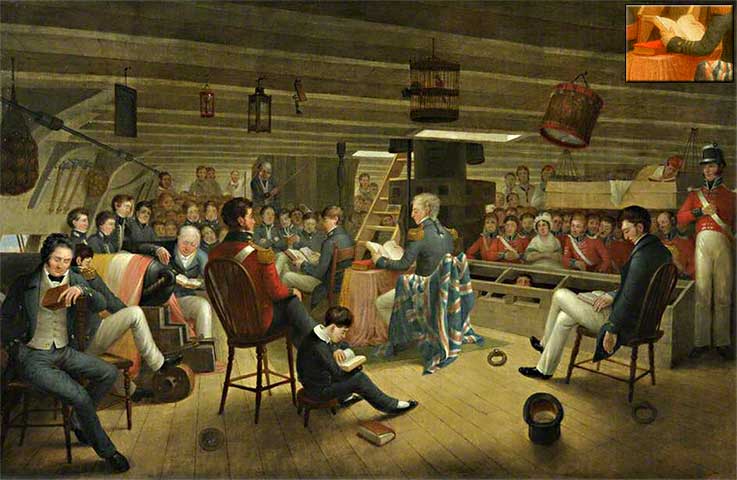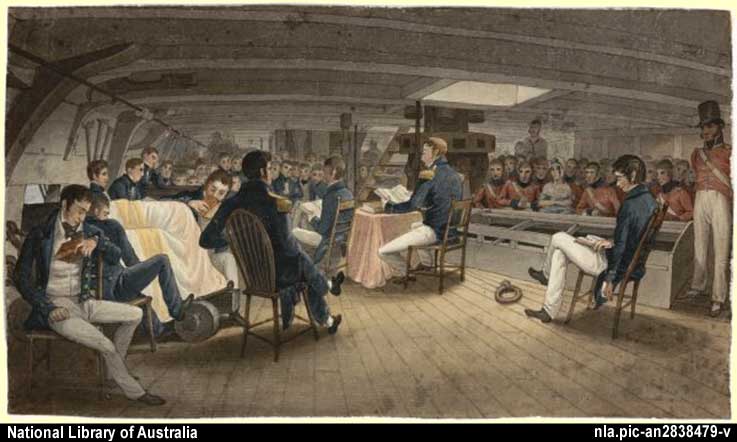



Augustus Earle's “Divine Service” Paintings
John Woram
One of Augustus Earle's “Divine Service” paintings is sometimes said to be a scene from the second voyage of HMS Beagle as it made its way to Tierra del Fuego to return the three Fuegians to their native land and resume the survey of South America. This page takes a closer look at the painting's relation to the Beagle, its captain and, of course, Charles Darwin.
At the National Center for Science Education website, an unidentified writer states in “Setting the Record Straight,” (PDF, p. 18) that:
Janet Browne, in her exhaustive account of the voyage “… explains why the ‘last and greatest’ painting by Darwin's shipmate, August [sic, Augustus] Earle, Divine Service as It Is Usually Performed on Board a British Frigate at Sea (1837), ‘probably portrays the Beagle company, for it is a subtle panorama of the wide range of theological opinion that could be embraced by just such a set of travellers. The captain is seated in a flag-draped chair below decks intent on the Bible before him. Except for his grey sailor’s queue, he looks like FitzRoy. A woman close by, otherwise unusual on a ship, is probably Fuegia Basket in her royal bonnet. Another figure, who must be Darwin, sits to one side hardly looking at his book although following the words for all that, and the junior officers, the young midshipmen, and sailors show varying degrees of intentness’ [Browne, pp. 326-327]. Even if the painting is not of the Beagle, the artist surely composed the panorama drawing on memories of his life at sea with Darwin.
To which author James Taylor (The Voyage of the Beagle: Darwin's extraordinary adventure aboard FitzRoy's famous survey ship) comments (p. 133):
Earle's painting was … entitled Divine Service as it is Usually Performed on Board a British frigate at Sea (also exhibited at the Royal Academy in 1837). It has been suggested by some writers (including Dr Janet Browne [see above]) that this picture portrays Darwin, FitzRoy (as the captain reading the Bible) and Fuegia Basket.§ This is wishful thinking.
§ No other writers have been located (yet).
A close look at the painting is about all it takes to verify that this indeed is not HMS Beagle:

Divine Service as it is Usually Performed on Board a British Frigate at Sea (ca. 1820-1837)
Royal Museum, Greenwich
- The presiding officer has three stripes on his left arm (see detail view, upper right), indicating the rank of commander. At the time of Earle's presence on the Beagle, FitzRoy was a lieutenant (two stripes),
- Neither the man at lower left nor the presiding officer bear any resemblance to Charles Darwin and Robert FitzRoy,
- The seated figure next to the small boy is a Marine colonel (National Maritime Museum description). There were none on the Beagle. John Baisley, Sergeant of Marines, was the highest marine rating aboard,
- The “sick man in the cradle, his head propped in his hand as he reads from the open book, immediately above the marines” (National Maritime Museum description) would be in the Beagle's Sick Bay, far forward,
- The man to the left of the colonel (right arm resting on cannon) appears to be in his 50s-60s. On leaving England, the oldest man in the Beagle crew was Pursor George Rowlett, age 35,
- FitzRoy placed six brass cannon (six pounders) on the main deck; none were below deck, nor as large as the one in the painting,
- The woman sitting at right is clearly too old to be Fuegia Basket,
- York Minster and Jemmy Button are both conspicuous by their absence.
For still more proof, all that's needed is a quick look at an earlier work by the same artist:

Divine Service on Board a British Frigate, H. M. S. Hyperion 1820
National Library of Australia
Remove the bulleted list for a closer comparison.
Note that here the ship is identified by name and the painting is dated 1820—more than ten years before Earle joined the Beagle. By changing the title from the specific HMS Hyperion to an un-named “British Frigate,” it is apparent that although the earlier painting does represent a scene on HMS Hyperion, Earle subsequently re-worked it to depict a typical shipboard service, not one held on a specific vessel.